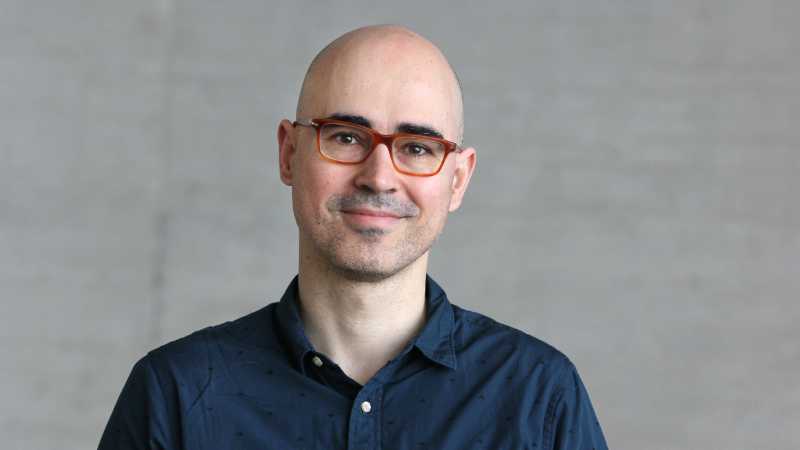Cells have to perform complex tasks: They divide, migrate and form tissues. To perform each of these tasks, cells build specialized structures. These structures are similar to roads or buildings in a city, but they need to be built and taken down very quickly. Cells are able to do this because these structures form spontaneously from the way molecules interact with each other collectively. This self-organizing process enables cells to adapt quickly to changes as needed. The Catalan physicist Prof. Jan Brugués is now conducting research at the Physics of Life (PoL) Cluster of Excellence on how biology uses physical principles to achieve the self-organization of cells. At TU Dresden, he holds the professorship for the Spatiotemporal Organization of Subcellular Structures at the Center for Molecular and Cellular Bioengineering.
Physics of molecules leads to biological functions
“How do the building blocks in our cells know how to organize a particular structure?” asks Prof. Jan Brugués. “Thanks to the enormous progress in molecular biology in recent decades, we now have a list of all the building blocks of life. Yet we still don't understand how they come together to build cells and tissues. In my opinion, this is one of the greatest challenges of modern biology. In my lab, we want to contribute to answering this question by studying how the properties of molecules lead to new biological functions at larger scales.” Behind this is the question of how information is transmitted across different scales: from DNA to molecules to subcellular structures all the way to an organism's body plan. To find answers, the research group also develops new tools and methods for measuring and analyzing data. They then combine these measurements with cell biological and theoretical approaches. “Ultimately, our goal is to answer fundamental biological questions using physics, but also to contribute to the discovery of new physics.” Prof. Brugués is convinced that Dresden, and in particular the Cluster of Excellence PoL, offers the perfect scientific environment to bring biology and physics together and to enable his research possible.
New research synergies
Prof. Campàs, managing director and speaker of the Cluster of Excellence Physics of Life, agrees that the interdisciplinary science community in Dresden is ideally suited to answer research questions that span disciplines and scales. “Our main goal at PoL is to uncover the physical principles underlying the organization of living systems across scales, from the molecular level to the organism. With his expertise in discovering physical principles governing subcellular structures, while bridging the molecular and cellular scales, Prof. Jan Brugués complements perfectly the current research strengths at PoL. His research will strongly synergize with our expertise on the physics of multicellular systems, biomolecular condensates, synthetic biology, and beyond.” says Prof. Campàs.
About Jan Brugués
Jan Brugués obtained his M.Sc. in Theoretical Physics in his hometown of Barcelona in 2004. By 2008, he had obtained his Ph.D. in Biological Physics from the University of Barcelona and the École Supérieure de Physique et de Chimie Industrielles in Paris. As a Human Frontier Science Program postdoctoral fellow, he moved to Harvard University in Boston, USA, to learn more about experimental methods and biological systems. His own interdisciplinary research group followed in 2013 at the Max Planck Institute for Molecular Cell Biology and Genetics and the Max Planck Institute for Physics of Complex Systems in Dresden. He became a member at the Center for Systems Biology Dresden in 2014. Among other awards, Jan Brugués also received the Career Development Award of the Human Frontier Science Program in 2014 and an ERC Consolidator Grant in 2022. Since December 2022, he holds the W3 professorship for the Organization of Subcellular Structures in Space and Time at the Cluster of Excellence Physics of Life at TU Dresden.
About the Cluster of Excellence Physics of Life
Physics of Life (PoL) is one of three clusters of excellence at TU Dresden. It focuses on identifying the physical laws underlying the organization of life in molecules, cells and tissues. In the cluster, scientists from physics, biology and computer science are investigating how active matter in cells and tissues organizes itself into given structures and gives rise to life. PoL is funded by the DFG within the framework of the Excellence Strategy. It is a cooperation between scientists of the TU Dresden and research institutions of the DRESDEN-concept network, such as the Max Planck Institute for Molecular Cell Biology and Genetics (MPI-CBG), the Max Planck Institute for the Physics of Complex Systems (MPI-PKS), the Leibniz Institute of Polymer Research (IPF) and the Helmholtz-Zentrum Dresden-Rossendorf (HZDR).
Media inquiries
Dr. Maria Begasse
Tel.: +49 351 463-41244
pr.pol@tu-dresden.de
